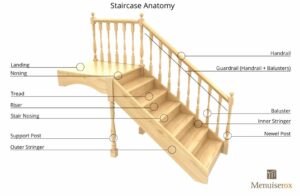Staircase Anatomy

Staircase Anatomy
There are many parts that go into making a staircase. Each of these parts deserve to be presented one by one. At Menuiserox, we manufacture a wide range of staircase components and we know the usefulness of each of them. Here is an overview of a standard staircase showing each of its components.

Landing: It is a horizontal flat surface wider than a regular tread. It is used for changing the direction of the stairs or for resting purposes. The landing can also serve as a transition between the staircase and the floor.
Nosing: It is the part of the tread or landing that extends beyond the face of the riser. The nosing on a landing tread is generally slotted into the floor, allowing for a smoother transition from the floor to the stairs, and also makes it easier to properly install the stringer.
Tread: It is the horizontal part of the staircase where we step on to go up or down. The tread is fixed horizontally to the stringer.
Riser: It is the vertical part of the step that separates two treads while making the link between them.
Stair nosing(bullnose): It refers to the edge of the tread. This is the part that extends beyond the riser, in other words the part that overhangs it. Also named bullnose, this part is generally rounded or square.
Newel Post: It is an elongated piece of various shapes installed vertically. The post is an important structural element, as it supports the projected loads against the handrail and the balusters while acting as a pillar. It is attached to the handrail as an anchor point.
Stringer: It is the main structural element of a staircase. The treads are installed horizontally on the stringer in order to hold them securely in place. The stringer is literally the backbone of the staircase.
Handrail: It is the part on which we put our hand on when we go up or down a staircase. When connected to the balusters, the handrail acts as a guardrail in front of a void.
Guardrail: It is made up of a succession of balusters assembled to a handrail in order to provide protection in front of a void.
Baluster: It is a small bar installed laterally and consecutively to support the ramp.
This summarizes the main parts of a standard staircase. For more information about the construction of a staircase, Menuiserox could refer you to a stair builder which specializes in this manner. In addition to all of those components to make it up, several technical aspects must be considered during its construction, such as the right size of the treads and the good space between each of them, for example.
To find an expert in staircase installation, Menuiserox can refer you to one of its partners located in your area. Contact us today about it.
